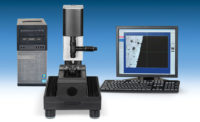Leica Geosystems joined hands with the Mariners' Museum and MAGLEV Inc. (McKeesport, PA) for this data acquisition project resulting in an accurate 3-D digital replica of the anchor. The handheld scanner allowed the team to capture the 3-D object in a fast, unfettered manner. The Leica T-Scan works in tandem with the Leica Laser Tracker, a portable coordinate measurement system.
Senior metrologists from Leica Geosystems and MAGLEV gathered at the Mariner's Museum for the two-day endeavor. The museum workers each had a chance to use the device and capture digital data from the anchor. This surface data will form the foundation of a highly detailed 3-D computer model that can be used for measurement, documentation and archival records. This digital record of the anchor's construction also can be used to monitor the anchor's condition, and to reproduce physical prototypes for merchandising and exhibit purposes.
The Mariners' Museum has worked conjointly with NOAA and the U.S. Navy to obtain more than 1,100 artifacts from the Monitor, including the anchor, steam engine, propeller and revolving gun turret. The Mariners' Museum and NOAA are working toward constructing and opening a new USS Monitor Center in March 2007. A full-scale replica of the Monitor warship will serve as the dynamic focal point of the center.


